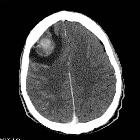gestational trophoblastic disease

Gestational
trophoblastic disease • Complete hydatidiform mole with bilateral theca lutein cysts - Ganzer Fall bei Radiopaedia

Gestational
trophoblastic disease • Complete molar pregnancy and coexisting live fetus - Ganzer Fall bei Radiopaedia

Gestational
trophoblastic disease • Molar pregnancy - Ganzer Fall bei Radiopaedia

Gestational
trophoblastic disease • Gestational trophoblastic disease - invasive mole - Ganzer Fall bei Radiopaedia

Gestational
trophoblastic disease • Partial hydatidiform mole - Ganzer Fall bei Radiopaedia

Gestational
trophoblastic disease • Complete hydatidiform mole with bilateral theca lutein cysts - Ganzer Fall bei Radiopaedia

Uterine
choriocarcinoma • Choriocarcinoma - Ganzer Fall bei Radiopaedia

Molar
pregnancy • Complete hydatidiform mole - Ganzer Fall bei Radiopaedia

Gestational
trophoblastic disease • Complete hydatidiform mole - Ganzer Fall bei Radiopaedia
Gestational trophoblastic disease (GTD) results from the abnormal proliferation of trophoblastic tissue and encompasses a wide spectrum of diseases, including:
- hydatidiform mole
- invasive mole ~10%
- choriocarcinoma (gestational choriocarcinoma) ~1%
- placental site trophoblastic tumor (PSTT)
- epithelioid trophoblastic tumor (ETT)
Epidemiology
Women older than 40 years and younger than 20 years may be at higher risk.
Clinical presentation
The presentation is variable:
- uterus larger than pregnancy age
- abnormally high β-hCG
- hyperemesis
- hypertension
- theca-lutein cysts
Pathology
A common characteristic of all gestational trophoblastic disease is an abnormal proliferation of trophoblast, but different components predominate in different tumors.
Classification
- hydatidiform mole
- complete hydatidiform mole (CHM)
- commonest (up to 80%) manifestation of GTD
- 46XX or 46XY: paternal chromosomes only
- no fetus
- β-hCG markedly elevated
- atypia of cells present
- treatment involves
- curettage +/- hysterectomy in older women
- follow-up urinary β-hCG for 6-12 months
- may progress to
- invasive mole: ≈15%
- choriocarcinoma: ≈5%
- partial hydatidiform mole (PHM)
- 69XXX or 69XXY (paternal and maternal chromosomes)
- may have a fetus or fetal components
- β-hCG moderately elevated
- no cellular atypia
- complete hydatidiform mole (CHM)
- invasive mole
- distorts uterine zonal structures
- boundaries between a tumor and myometrium are irregular and indistinct
- may also invade parametrial tissue and blood vessels
- gestational choriocarcinoma
- may look identical to hydatidiform mole
- arises following known molar pregnancy (50%), miscarriage (30%), normal pregnancy (20%)
- can appear to have less vascularity than an invasive mole
- higher β-hCG levels even than a complete mole
- solid component with the visualized invasion
- tends to invade myometrium through venous plexuses
- patients often can present with multiple metastases without an easily identified primary, as it can often be small in an otherwise normal placenta
- metastases can occur in
- lungs: ~80%
- vagina: ~30%
- pelvis: 20%
- liver and brain: ~10%
- placental site trophoblastic tumor (PSTT)
- rare form
- produces small amounts of β-hCG
- epithelioid trophoblastic tumor (ETT)
- extremely rare form
Siehe auch:
- Blasenmole
- Chorionkarzinom
- partial hydatidiform mole
- complete hydatidiform mole
- gestational choriocarcinoma
- invasive mole
- mesenchymale Dysplasie der Plazenta
- epithelioid trophoblastic tumour (ETT)
- ovarian theca lutein cysts
- placental site trophoblastic tumour
- placental site trophoblastic tumour (PSTT)
und weiter:
- obstetric curriculum
- early pregnancy
- Ovarialzyste
- cancer
- junctional zone
- complete mole
- hydropic degeneration of the placenta
- retained products of conception
- differential diagnosis for bleeding in pregnancy
- empty gestational sac
- verhaltener Abort
- Abortivei
- fruit inspired signs
- per vaginal bleeding in the exam
- arteriovenöse Malformation des Uterus
- maligne Uterustumoren
- chorioadenoma destruens
- Ovarielles Hyperstimulationssyndrom
- coexistant molar pregnancy
- Chorionkarzinom des Uterus

 Assoziationen und Differentialdiagnosen zu gestational trophoblastic disease:
Assoziationen und Differentialdiagnosen zu gestational trophoblastic disease:




